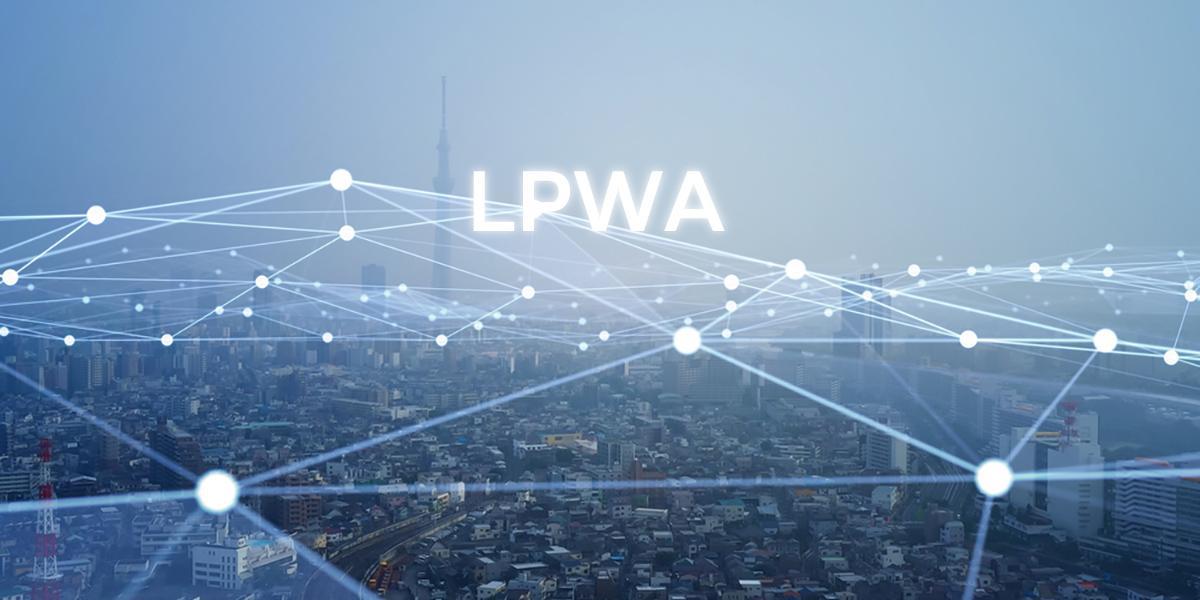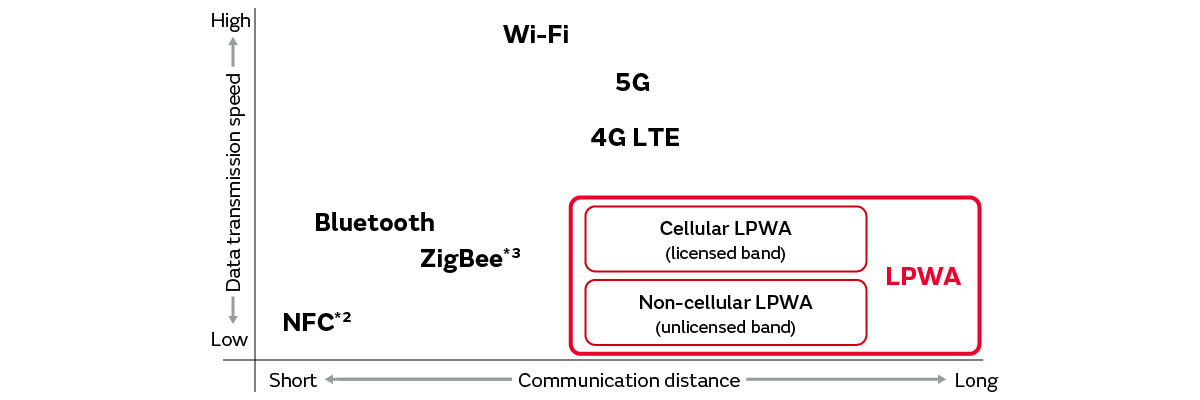LTE Cat.M1/NB-IoT Modules


Index: Basics
2.1 Features of LPWA (1): Low Power Consumption
2.2 Features of LPWA (2): Long-distance Wireless Communication
3.1 LPWA Types: Cellular LPWA and Non-cellular LPWA
3.2 Cellular LPWA and Non-cellular LPWA Standards
3.3 Cellular LPWA and Non-cellular LPWA Specifications Comparison
4. LPWA Utilization Examples
5. Murata Manufacturing’s LPWA Modules
LPWA is an abbreviation for Low-Power Wide-Area. It is also referred to as Low-Power Wide-Area Network (LPWAN). LPWA is wireless communication technology that features low power consumption and wide-area and long-distance communication. Although the amount of communication data is small and it is slower than Wi-Fi and other networks, communication over 10 km is possible. The long-distance communication of small-size data is sought in the utilization of the Internet of Things (IoT) and Machine to Machine (M2M) in the smartification of factories, logistics, agriculture, housing, life infrastructure, and other facilities. Therefore, LPWA is attracting attention as the fundamental wireless communication technology behind IoT and M2M.
We explain here the differences between LPWA*1 and other wireless communication methods and, in particular, the major features of LPWA in terms of its low power consumption and long-distance communication. Fig. 1 shows the relationship between communication distance and communication speed (data transmission speed) in LPWA and other wireless communication methods. In addition to its longer communication distance than other communication methods, we can see that LPWA has a low data transmission speed; in other words, it is slow.

*1: LPWA is divided into cellular LPWA (licensed band) and non-cellular LPWA (unlicensed band). We explain these types and the various standards in “3. LPWA Types and Standards” below.
*2: Near Field Communication (NFC) is wireless communication technology with a maximum communication distance of about 10 cm. NFC has been adopted in contactless IC cards for public transportation and similar applications.
*3: ZigBee is short-distance wireless communication technology that makes it possible to directly connect between devices to build networks. It has a low speed (maximum of 250 kbps) and low power consumption. Accordingly, it has been adopted in IoT equipment (sensor data communication and remote control of home appliances, etc.).
The communication speed is high from Mbps to Gbps in data communication using 4G LTE and 5G used in smartphones and other such terminals. Along with that, the power consumption required for communication also increases.
On the other hand, the size of the data required for the sensing and control of many of the devices used in IoT and M2M is small. Accordingly, IoT and M2M can be operated sufficiently with low-speed communication. Therefore, LPWA, which has been designed to be used in IoT and M2M, can keep power consumption low due to its low communication speed. In fact, the battery life of LPWA modules is 10 years or more. That means efficient operation is possible in various installation locations. For example, it is possible to dramatically reduce the frequency of battery replacement in IoT devices.
When considering short-distance data communication from several meters to several hundred meters, the candidates are usually a type of Personal Area Network (PAN) called Bluetooth® or a type of wireless Local Area Network (LAN) called Wi-Fi. On the other hand, there are many cases in fields such as IoT and M2M, which require data communication to monitor and operate IoT devices that have been installed over a wide area, from several kilometers to dozens of kilometers. That means there is a need for wireless technology that enables longer-distance communication than wireless PAN or wireless LAN.
LPWA is a wireless communication technology designed to satisfy the requirement of long-distance communication as is needed in the IoT era. It mutually transmits small-size data over long distances including the sensor values output by IoT devices installed in distance places, data to identify the location of those devices, and control data sent to them.
LPWA is divided into cellular LPWA and non-cellular LPWA*4. In addition, each of these has its own standards. There are differences in the specifications including the frequency bandwidth used, the communication distance, and the transmission speed.
*4: In Japan, cellular LPWA is sometimes called “cellular-based” or “licensed-based” LPWA, while non-cellular LPWA is sometimes called “non-cellular-based” or “unlicensed-based” LPWA.
To start with, we will explain both cellular LPWA, which uses a frequency band requiring a radio station license (licensed band), and non-cellular LPWA using a frequency band not requiring a radio station license (unlicensed band).
The base stations and communication networks of carriers are generally used in cellular LPWA, which requires a radio station license (Fig. 2). However, it is necessary to have an environment in which communication from IoT equipment equipped with LPWA modules to the base stations is stable. Accordingly, the areas between IoT equipment and base stations tend to be areas with a high density of people such as urban districts, residential districts, and industrial districts.
Non-cellular LPWA, which we talk about later, is selected in areas distant from urban districts such as mountainous regions and isolated islands where communication to base stations is difficult.

*5: A Subscriber Identity Module (SIM) is literally a module that identifies the subscriber. Equipping a SIM compatible with a carrier with which you have a contract in a device or module allows you to use the communication network of that carrier with cellular LPWA, which uses licensed bands requiring a license.
Examples of the utilization of cellular LPWA include data collection in electricity, gas, water, and other life infrastructure, and tracking of packages in international logistics with roaming*6 of the communication networks of carriers in each country.
*6: Roaming generally refers to a service that enables the use of a communication network of a local carrier affiliated with the carrier with which you have a contract outside the service provision area of your carrier. Such services provided internationally are also called “international roaming.”
Please see “4. LPWA Utilization Examples” in “What Is Low-Power Wide-Area (LPWA) Wireless Communication? - Utilization” for details of the examples.
Non-cellular LPWA uses the 920 MHz band, which is a sub-GHz band that does not require a radio license in Japan. As shown in Fig. 3, it is possible to send data obtained through a gateway*7 from an LPWA module to a network server or app server without using the communication network of a carrier.

*7: Gateway: The communication protocol (regulations that define the procedures at the time of communication and data format, etc.) is determined to enable communication between equipment in wireless and wired communication. It is not possible to directly communicate between equipment or between networks with differing communication protocols. A gateway is a piece of equipment or software to solve this issue. It enables a relay connection by converting the protocols.
Examples of the utilization of non-cellular LPWA include long-distance communication applications that cannot be covered by cellular LPWA, such as communication in environments where it is difficult to connect to the base stations of carriers including mountainous regions and isolated islands, and communication in a private network.
Please see “4. LPWA Utilization Examples” in “What Is Low-Power Wide-Area (LPWA) Wireless Communication? - Utilization” for details of the examples.
We explain here the standards and features of both cellular LPWA and non-cellular LPWA.
There are two standards for cellular LPWA that uses the base stations and communication networks of carriers: LTE Cat. M1 (LTE-M) and NB-IoT. Both standards use free bandwidth in the LTE frequency band (700 MHz to 3.5 GHz). We give the features of both below.
LTE Cat. M1 (LTE-M) is the abbreviation for LTE Category M1. It is also called LTE for Machine-type communication (LTE-M). The maximum speed is 1 Mbps for both uplinks and downlinks. The maximum communication distance is approximately 10 km. Communication is also possible while walking, riding a bicycle, driving a car, or otherwise moving. It is suitable for IoT devices that transmit location information while moving as applications. This includes, for instance, the monitoring of children and logistics cargo trackers.
NB-IoT is the abbreviation for Narrow Band IoT. Although the maximum speed is slow at 62.50 kbps for uplinks and 26.15 kbps for downlinks, it has a maximum communication distance of approximately 40 km. It is not suitable as an application for communication while moving. However, it is suitable, for example, for smart meters fixedly installed over a wide area and IoT devices that have crime prevention and alarm functions.
Please refer to Tab. 1 in the next section “3.3 Cellular LPWA and Non-cellular LPWA Specifications Comparison” for the differences in both standards.
Moreover, you can see the LPWA modules compatible with these two standards on the following page: “5. Murata Manufacturing’s LPWA Modules” in “What Is Low-Power Wide-Area (LPWA) Wireless Communication? - Utilization.”
There are multiple standards for non-cellular LPWA including LoRaWAN as well as Sigfox, Wi-SUN, ZETA, and ELTRES. All these standards use the sub-GHz band. The communication speed of most of these standards is around 100 bps to 250 kbps. The communication distance varies greatly depending on the standard from about 2 km to 100 km. There is a tendency for the communication speed to be slower the longer the communication distance.
You can see the LPWA modules compatible with LoRaWAN on the following page: “5. Murata Manufacturing’s LPWA Modules” in “What Is Low-Power Wide-Area (LPWA) Wireless Communication? - Utilization.”
Tab. 1 shows the specifications using as an example the LTE CAT. M1 (LTE-M) and NB-IoT cellular LPWA standards and the LoRaWAN non-cellular LPWA standard. This table also includes as a reference the specifications of LTE Cat. 1, which has a higher communication speed and communication cost than the current standards of LPWA. It mainly compares the necessity of a radio station license (or whether the environment allows stable communication with base stations), the communication distances, and the communication speeds to serve as a reference when choosing which standard to use.
Tab. 1: Specifications Comparison of the Main Standards of Cellular/Non-cellular LPWA and LTE (Reference) (as of June 2023)
Type of LPWA | LTE (Reference) | |||
|---|---|---|---|---|
Cellular LPWA | Non-cellular LPWA | |||
Standard | LTE Cat. M1 (LTE-M) | NB-IoT | LoRaWAN | LTE Cat.1 |
Radio station license | Frequency band requiring a license (licensed band) | Frequency band not requiring a license (unlicensed band) | Frequency band requiring a license (licensed band) | |
Maximum communication distance | Approx. 10 km | Approx. 40 km | Dozens of kilometers | Approx. 5 km |
Maximum communication speed | Downlink: 1 Mbps | Downlink: 26.15 kbps | Downlink: 250 bps | Downlink: 10 Mbps |
Transmission power | +23 dBm | +23 dBm | +20 dBm * | +23 dBm |
Device battery life | 10 years or more | - | ||
Power consumption | Low | Low | High | |
Cost (at the time of deployment) | Low | Low | High | |
* +20 dBm is for the U.S. only. It is +14 dBm in the EU/Asia.
There were cases in which wiring became the bottleneck to installation in the process of the IoT and M2M technologies spreading widely from the manufacturing industry to the home.
For example, the more complex wiring and increased man-hours at the time of setup changes become issues when connecting cables for power supply and communication to each IoT device that handles small-size data like general-purpose sensors in factories.
A desire emerged for battery drive and wireless communication to resolve those issues. However, when using Wi-Fi, for example, problems arise in factory facilities with large premises. Those problems include insufficient communication distance and a shortened battery life due to high-speed communication. Moreover, LTE used in mobile phones is also high-speed communication. Therefore, problems arise such as high usage costs due to the large power consumption in devices making it necessary to frequently charge them. (In fact, a standard called LTE Cat. 1 (reference: “3.3 Cellular LPWA and Non-cellular LPWA Specifications Comparison”) was initially used.) The amount of communication data in IoT/M2M devices such as general-purpose sensors in factories and control of electrical products in the home is small in the first place. That means it is not necessary to use high-speed communication.
This is also the same for the smartification of electricity, gas, water, and other life infrastructure installed in large numbers in a wide area. The size of the data communicated by smart meters is small. Therefore, there was an issue of how to realize low-speed, low-power consumption and long-distance wireless communication at low cost for that.
Accordingly, there was a desire for the specifications necessary for IoT/M2M applications; in other words, wireless technology capable of low-speed communication sufficient for a small amount of communication data, low-power consumption from that, and long-distance communication. LPWA was proposed as wireless technology to satisfy these specifications. Currently, LPWA standards are being provided by various companies and organizations. For example, the arrival of the LTE CAT. M1 (LTE-M), NB-IoT, and other standards we have introduced in this text has meant that LPWA has come to be widely utilized as a leading method of wireless communication in the IoT/M2M field.
4. LPWA Utilization Examples
4.1 Smartification of Life Infrastructure (Smart Meters) [Cellular LPWA]
4.2 Smartification of Houses and Facilities (Smart Homes and Smart Locks, Etc.) [Cellular LPWA / Non-cellular LPWA]
4.3 Tracking of People, Things, and Other (Wearable Devices/Trackers) [Cellular LPWA]
4.4 Environmental Monitoring and Smartification of Agriculture [Cellular LPWA / Non-cellular LPWA]
4.5 Use of Smart Payment Terminals Outdoors [Cellular LPWA]
4.6 Remote Monitoring of Medical Equipment (CPAP Devices) [Cellular LPWA]
5. Murata Manufacturing’s LPWA Modules
5.1 Strengths of Murata Manufacturing’s LPWA Modules
5.2 LPWA Module Lineup